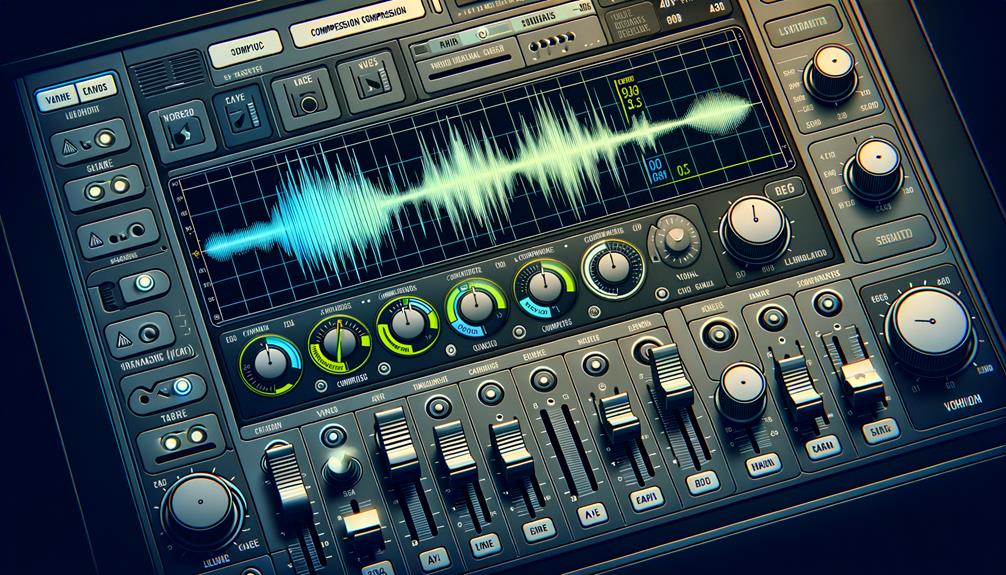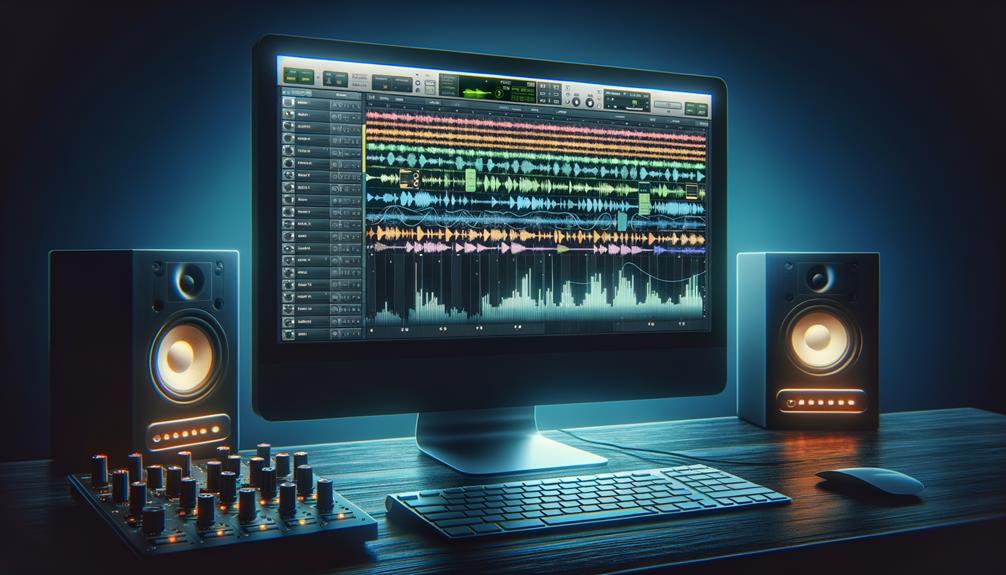No products in the cart.
You’ve probably heard the saying ‘the devil is in the details,’ and when it comes to mixing vocals in FL Studio, this couldn’t be more true.
You may have the perfect vocal take, but without the right mixing techniques, it can get lost in the mix. In this discussion, we’ll explore the essential steps and advanced techniques for achieving a professional vocal mix in FL Studio.
From cleaning and balancing the vocals to applying EQ and compression, each step plays a crucial role in making your vocals stand out in the mix.
So, let’s dive into the intricacies of vocal mixing and uncover the secrets to achieving a polished and professional sound.
Contents
hide
Key Takeaways
- Setting up proper vocal tracks in FL Studio is essential for capturing clear and high-quality vocals. This includes adjusting input gain, using the mixer for processing, and setting up a send track for vocal effects.
- Understanding vocal EQ is crucial for achieving a balanced and professional sound. This involves using parametric EQ for tonal balance, removing unnecessary low frequencies, sweeping for unwanted resonances, and experimenting with boosts and cuts for clarity and presence.
- Compression plays a vital role in controlling the dynamics of vocal tracks. It is important to adjust the threshold, ratio, attack, and release parameters to achieve the desired level of compression and balance.
- Adding depth to vocal tracks can be achieved through the use of reverb and delay effects. Adjusting the decay time and controlling the dry signal and feedback levels will help create a natural and spacious feel. It is important to avoid overpowering the vocals with excessive delay.
Setting up Vocal Tracks in FL Studio
When setting up vocal tracks in FL Studio, create a new audio track and set the input to your microphone or audio interface. Adjust the input gain to ensure the vocals are recording at an optimal level without clipping.
Utilize FL Studio’s mixer to apply EQ, compression, and other processing to enhance the vocal recording. To enhance the vocals, use Fruity Reverb to add depth and dimension. Additionally, setting up a send track for vocal effects, such as reverb or delay, can further enrich the vocal sound.
When processing vocal tracks, consider applying a low-cut filter to remove unwanted low-frequency rumble or noise. This helps to clean up the vocal recording and make it sound more professional.
Understanding Vocal EQ and Its Application
After setting up vocal tracks in FL Studio, the next crucial step is understanding vocal EQ and its application in achieving a clean, balanced vocal sound. Utilize a parametric EQ to shape the vocal’s tonal balance.
Use high pass filters to remove unnecessary low frequencies, clearing up sonic space and preventing muddiness. Sweep for unwanted resonances that can cause harshness or boxiness in the vocals. Experiment with gentle boosts and cuts to enhance the vocal’s clarity and presence.
Consider using your studio monitors or high-quality headphones to accurately perceive the changes in the vocal sound. Apply a reverb subtly to create a sense of space without overwhelming the vocals. Be cautious not to add too much reverb, as it can make the vocals sound distant or washed out.
Utilizing Compression for Vocal Balance

To achieve optimal vocal balance, employ compression as a fundamental tool for controlling dynamics and ensuring a polished and professional vocal sound. Utilizing compression for vocal balance in FL Studio involves using stock plugins or third-party compressors to manage the dynamic range of the vocals. Adjust the threshold to control the level at which compression begins to apply. Set the ratio to determine the amount of gain reduction applied once the signal surpasses the threshold. The attack parameter regulates how quickly the compression reacts to the input signal, while the release controls how long the compressor takes to stop compressing after the input drops below the threshold. Utilize multi-layered compression techniques to intricately control vocal dynamics, contributing to a more professional sound. Experiment with parallel processing techniques to add creative effects and achieve a louder final mix. Remember to use your ears when adjusting compression settings, as the goal is to maintain vocal clarity and control volume fluctuations for a balanced sound. Load up fruity and add delay to enhance the vocal presence and depth.
| Compression Settings | Description |
|---|---|
| Threshold | Control compression level |
| Ratio | Determine gain reduction |
| Attack | Regulate compression speed |
| Release | Control compression duration |
Adding Depth With Reverb and Delay
To further enhance the professional sound you’ve been shaping with compression, we’ll now explore how to add depth to your vocal mix using reverb and delay.
Adding depth with reverb and delay is crucial in creating a sense of space and dimension in your vocal mix. Reverb, with its long decay time, adds a natural and spacious feel to the vocals, making them sound as if they’re in a larger environment. Adjusting the decay time can help place the vocals within the mix, ensuring they don’t sound too distant or too close.
On the other hand, delay can add a sense of depth and dimension by creating echoes that enhance the vocals. Carefully adjusting the dry signal and feedback can help control the amount of delay and prevent it from overpowering the vocals.
Finalizing the Vocal Mix With Automation and Effects


Consider implementing automation to dynamically adjust vocal levels throughout the song, enhancing the overall polish and professionalism of your mix.
In FL Studio, automation allows you to create precise changes in volume, panning, and effect parameters over time. By automating vocal levels, you can ensure that the vocals remain prominent during key phrases and blend seamlessly during softer sections.
Additionally, effects play a crucial role in finalizing the vocal mix. Experiment with adding delay, reverb, and chorus to infuse depth and character into the vocals. Automation can also be applied to the wet/dry levels of these effects, creating subtle variations in the vocal texture.
Furthermore, using automation to control EQ parameters enables you to make specific tonal adjustments tailored to different parts of the song. In a home studio setup, these techniques can elevate the quality of your vocal mix, bringing it closer to professional standards.
Lastly, consider utilizing sidechain compression to help the vocals cut through the mix, especially when they compete with other instruments. These advanced techniques in automation and effects will undoubtedly take your vocal mix to the next level.
Frequently Asked Questions
Can You Mix Vocals in FL Studio?
You can definitely mix vocals in FL Studio. Use vocal effects, compression, EQ, reverb, delay, and automation to enhance the vocal sound. Experiment with third-party plugins and advanced techniques for more detailed control and a professional vocal mix.
How Do I Mix My Vocals?
To mix your vocals, start by using vocal compression to control dynamics. Apply EQ techniques to balance frequencies. Experiment with reverb settings for depth. Consider vocal layering and panning for dimension. Then, add vocal effects for creativity.
How Do I Clean Vocals in FL Studio?
To clean vocals in FL Studio, apply vocal compression to control dynamics, use noise reduction to remove unwanted background noise, adjust EQ to roll off low frequencies and remove resonances, apply reverb for depth, use vocal doubling for richness, and employ de-essing techniques to reduce sharp sounds.
How Do You Mix Songs on FL Studio?
In FL Studio, you mix songs using vocal EQ to sculpt the tonal balance, compression techniques for dynamic control, and reverb settings and delay effects for spatial depth. Vocal doubling and panning vocals create a wide and immersive sound.
Conclusion
Now that you have learned the essential techniques for mixing vocals in FL Studio, you can confidently clean, balance, and enhance your vocal tracks.
With a solid understanding of vocal EQ, compression, reverb, and delay, you can achieve a professional sound and make your vocals stand out in the mix.
Remember to experiment with automation and creative effects to add depth and character to your vocal mix.
Keep practicing and refining your skills to achieve the best results.




